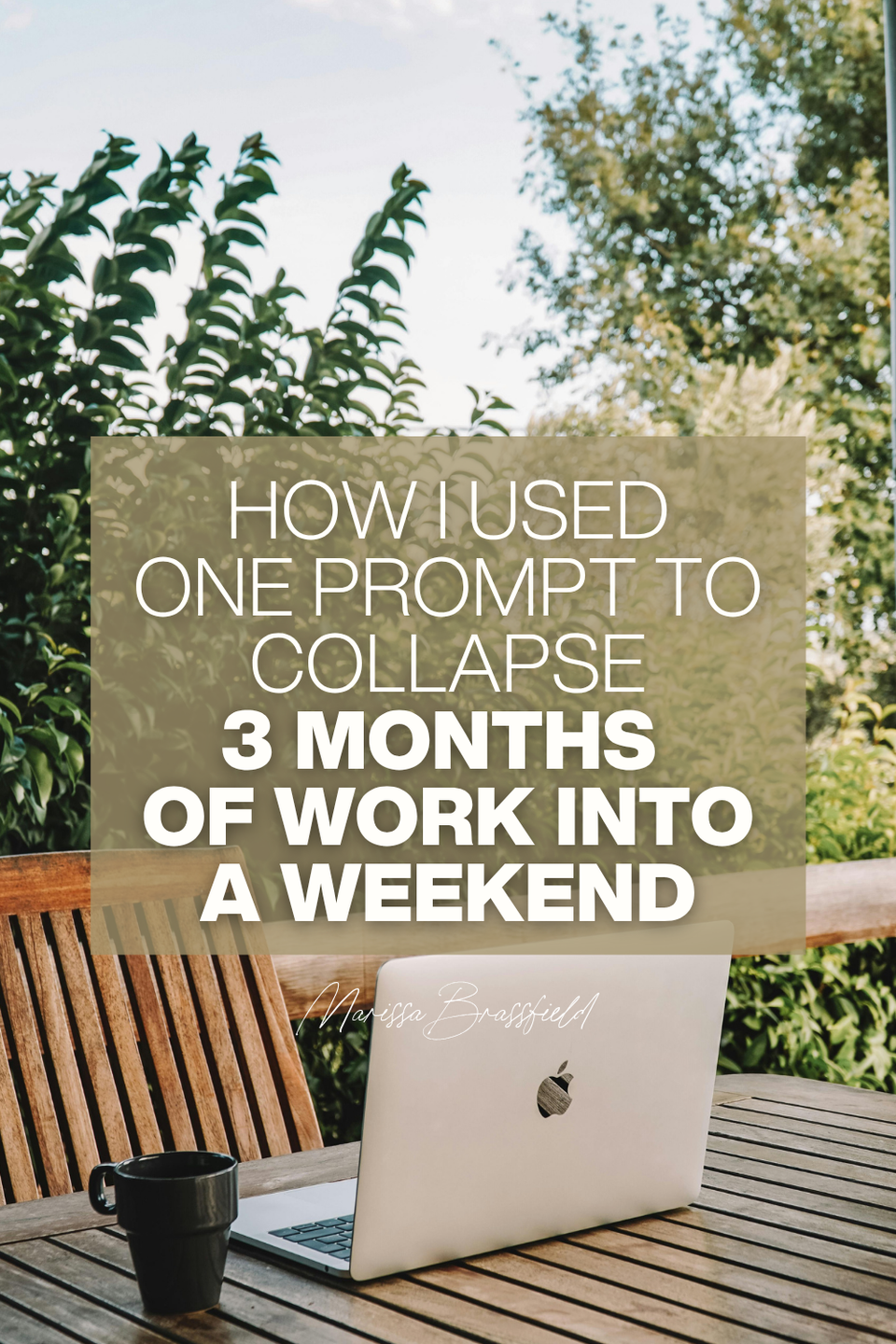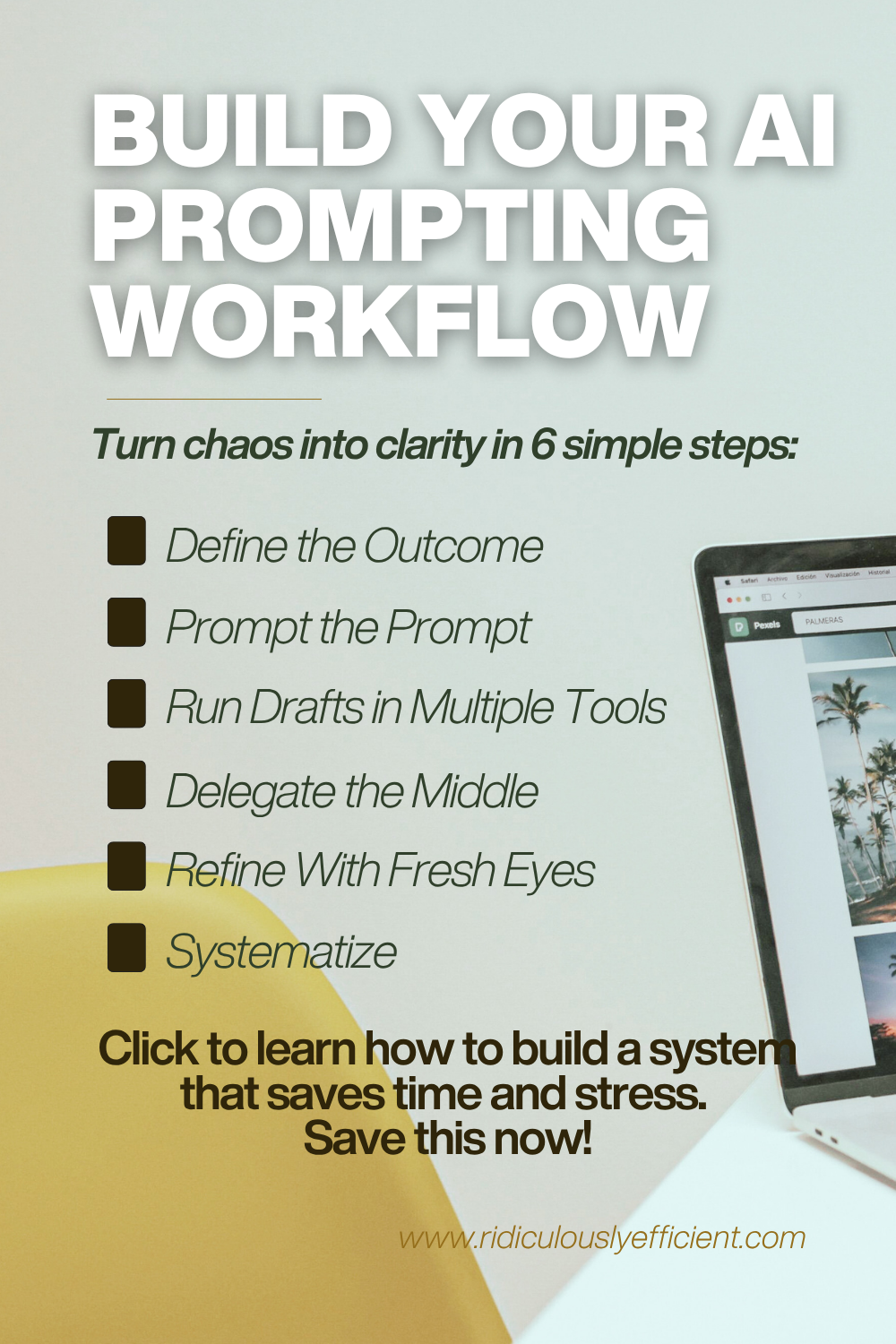
Ever stared down a massive project so intimidating that you put it off until it became an emergency?
Yeah, I’ve been there.
Recently, I had to design and document strategic systems, SOPs, and org-wide roles—including for positions that didn’t even exist yet—for an entire company. The kind of work that usually takes an entire quarter to complete. Strategic, complex, layered.
And I delayed. Not because I’m lazy—but because I knew exactly how much time, mental energy, and attention to detail it would take. I knew it would require full focus, and that’s hard to come by when you’re juggling multiple initiatives.
But here’s the twist: I finished it in two days.
With clarity. With confidence. With peace.
And AI made it possible.
I’m about to break down exactly how I:
- Used AI to collapse months of work into two days
- Applied the "prompt the prompt" method for better results
- Delegated strategically to my VA using AI-generated tasks
- Discovered where I add the most value in a human-AI collaboration
- Developed a repeatable, scalable workflow for high-leverage results
Let’s get into it.
Step 1: Recognize When You’re Procrastinating for a Reason
I wasn’t putting this project off out of laziness. I was overwhelmed by the scale of it:
- Define roles that had never existed before
- Build SOPs from scratch
- Create strategic infrastructure that touches every part of the business
- Deliver it in a way that sets the department up for long-term success
This isn’t checklist work—it’s high-stakes, high-impact thinking. I knew I needed time and space I didn’t have.
So I reframed the problem: What if AI could hold the initial weight of the thinking?
Step 2: Start Prompting Early — Even Before You Feel Ready
When the deadline hit, I had no more room to delay. So I started prompting.
And here’s the key: I didn’t just dive into one big prompt. I used what I call the "prompt the prompt" method:
Prompt #1: "Help me design the best prompt for creating a comprehensive SOP for a role that doesn't exist yet."
That meta-prompt gave me a thoughtful, detailed structure I could refine. Then I ran that new prompt in Claude, and later in ChatGPT, to test output variety and depth.
If you really struggle with prompts - check out this trove of starter ChatGPT prompts from Semrush.
Step 3: Delegate the Middle — Not the Thinking
The magic wasn’t just in prompting. It was in how I layered my workflow.
- I used Claude to run deep prompts and generate thoughtful draft content.
- I asked my VA to copy and paste output from specific chats into structured Google Docs.
- I woke up with the drafts in place, reviewed them with fresh eyes, and made high-level refinements.
The result? I saved hours. Literal hours.
And the final documents were better than if I had white-knuckled my way through every step.
Here’s why:
- AI gave me a first draft to react to
- My VA handled the formatting and collation
- I stayed in my zone of genius: editing, sense-making, guiding
This was a huge shift in how I see my role in human-AI collaboration.
Step 4: Prompt Your Way to Peace
The deeper lesson here?
Prompting isn’t just about productivity. It’s about peace.
By prompting first, I:
- Clarified the problem
- Identified the architecture of the solution
- Created a clear draft for others to work from
This allowed me to relax, trust the process, and even enjoy my day. While my 30-minute prompt ran in the background, I was eating kimchi pickles with my husband and tweaking my Formula 1 fantasy team. That’s a long way from bloodshot eyes glaring into a blank screen at 2 am.
Step 5: Lean Into Your Kolbe Instincts
This experience reminded me where I personally add the most value.
- Fact Finder/Follow Thru (6/6): I structure and clarify well
- Quick Start (Kolbe 8): I’m great at initiating
- Low Implementor (2): I shouldn’t be the one formatting or manually compiling
Half my AI use this week involved starting something and handing it off:
- I prompted the big idea
- I shaped the output
- I passed it to someone else for refinement or completion
That’s high-leverage work. Where human creativity, natural strengths, and role alignment meets scalable systems.
Step 6: Build Your Own High-Leverage Prompting Workflow
Here’s a version of my repeatable process that you can adapt:
- Define the Outcome – What exactly do you want to produce?
- Prompt the Prompt – Ask the AI to help you create the best possible prompt
- Run Initial Drafts – Use multiple tools (e.g. Claude, ChatGPT) to cross-reference quality
- Delegate Collation – Assign your VA or team to format, organize, or extract the best parts
- Refine With Fresh Eyes – Review in a high-energy state, make strategic decisions, and finalize
- Systematize – Save your best prompts, refine your process, and build a template bank

This is the Future of Work: AI + Human Collaboration
If you’re a founder, strategist, or leader doing deep knowledge work, AI isn’t just a productivity hack—it’s a thought partner. A collaborative force multiplier.
That’s what I mean by prompt your way to peace.
And that’s how I turned a project I dreaded into something I actually enjoyed building.
If you’d like to chat about how to design a new workflow that gives you hours and energy back, book a free call with me. Let’s get started!
P.S. Read this next if you want to dive deeper on my take on prompts that actually work.
Get fresh takes on work-life alignment, leadership, and optimizing quality of life.


Member discussion